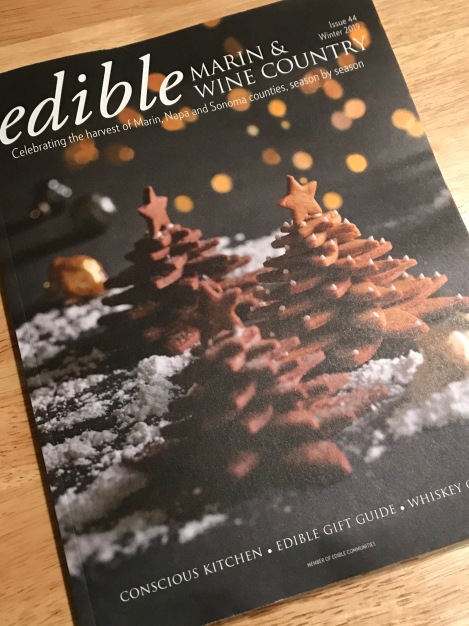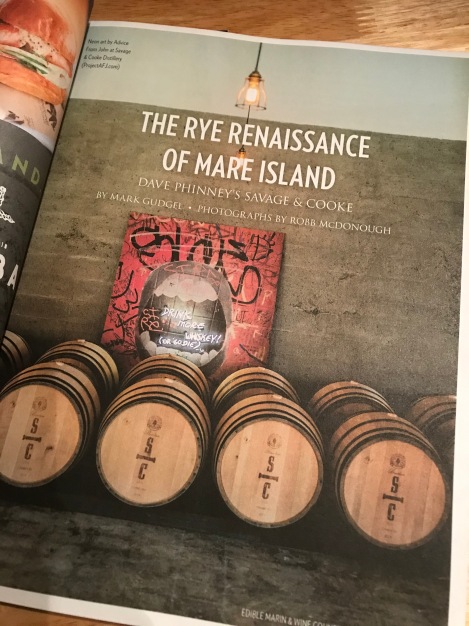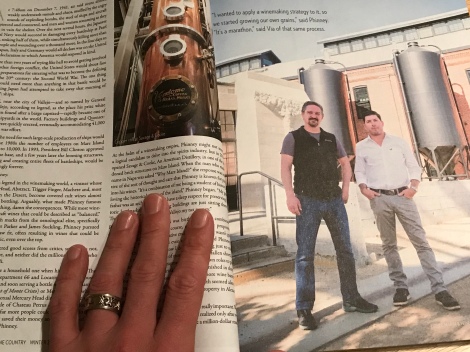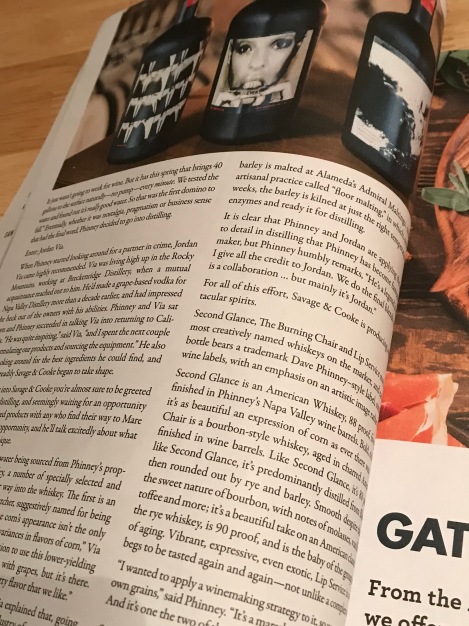525,600 minutes, right? It’s incredible to look back over a year and see how much has changed. Why, in just the last 2,880 minutes we’ve provoked Iran to war and, frankly, made me feel very uncertain about the future that my own small children will inherit. But on a lighter note, some pretty great things did indeed happen last year, and this morning — in keeping with my resolution to be a little more active in writing to you, dear readers, I thought I’d fixate on one of those great things that did indeed happen in 2019.
One of the triumphs of the past year was that I was hired as a wine writer by Edible Marin & Wine Country Magazine. To work for such an extremely well done and high quality print publication again, complete with excellent editors and photographers, is a real joy, and I’m currently wrapping up my second piece for the magazine right now. The editor, Gibson Thomas, is as intelligent as she is supportive, and I truly hope that I will have the opportunity to write for this magazine for the foreseeable future.
Below is the first piece I wrote for Edible Marin. You’re getting my last draft, not the published edited one, as I don’t have access to that file. I encourage you to subscribe to the magazine if you don’t already, or you can get an even better sense of it here: https://ediblemarinandwinecountry.ediblecommunities.com/. In writing it, I got to interview Dave Phinney, and you know how excited that made me. I also got to dig a little deeper into history, which of course was fun for me. I hope your weekend is off to a terrific start, friends! Enjoy the read.
Cheers,
Mark
“The Rye Renaissance of Mare Island”
For Edible Marin & Wine Country, Issue 44, Winter 2019

At 7:48 in the morning on December the 7th, 1941, air raid sirens droned weakly underneath tumult and chaos, muffled by the angry sounds of exploding bombs, the steel of ships and aircraft being pierced and forcefully contorted, and men and women screaming as they sought in vain to seek safety and shelter. Nakajima B5N Torpedo Bombers led the first of two waves in the unannounced attack that would later be deemed a war crime, as 353 aircraft laid siege upon the harbor of one small Pacific island. Over the course of the next several hours, the Japanese Imperial Navy would succeed in damaging every battleship at Pearl Harbor, sinking half of them, while simultaneously killing more than two thousand people and wounding over a thousand more. In the four days to follow, Japan, Italy, and Germany would all declare war on the United States, a declaration to which America would respond in kind. After more than two years of trying like hell to avoid getting involved in yet another foreign conflict, the United States would about face and begin preparations for entering what was to become the defining event of the twentieth century, the Second World War.
Aside from outlying areas like Hawaii, the United States of America was relatively impervious to attack during the era of the Second World War, with the two greatest anti-tank barriers ever constructed lapping up against her shores on the east and west. This geographical advantage had allowed, for a second time, that America could take an isolationist approach to the violence taking place in Europe. Joining the war meant going back “over there” into the European theater and, with the introduction of the Japanese as an enemy in WWII, fighting a two front war this time around. While Germany and Europe presented not only familiar enemies but familiar allies and familiar geography in which to wage this war, the island nation of Japan and the archipelago sprawled out below her presented a new enemy with new tactical challenges and comparatively little regional support. The one thing America would need more than anything in that battle would be the very thing Japan had attempted to take away from her that morning of December the 7th – ships.
On the mainland, US military operations busied themselves with war preparations. In Vallejo, and from a Naval standpoint, part of that business was building those ships that America would need on both fronts. Mare Island, named by General Mariano Vallejo according to legend as the place his prize white mare had been found after a barge capsized, rapidly became one of the busiest shipyards in the world. Quonset huts were rapidly erected to house the people needed to transform steel into weapons, and ships into fleets. Soon after the attack on Pearl Harbor, Mare Island employed over 41,000 workers in the war effort, nearly a quarter of whom were women. In short order, America was ready to enter the war. It would drag on for three more years, the casualties and crimes surpassing even the most morbid of imaginations.
Ultimately, and at an extremely high cost in every possible sense, the Allies would win World War II, and the need for such large-scale production of ships would ebb with the tide of war. In the 1960’s, the command of Mare Island would be combined with that of Hunter’s Point, another US Naval shipyard, and by the 1980’s the number of employees would dwindle to under ten thousand. In 1993, President Bill Clinton would approve the closure of the base, and a few years later the looming structures, equal to housing and creating entire fleets of battleships, would be shuttered, seemingly forever.
Enter: Dave Phinney.

Dave Phinney is a legend in the winemaking world, a vintner whose wines – Mercury Head, Abstract, Trigger Finger, Machete, and, most recently, 8 Years in the Desert, become coveted cult wines almost immediately upon bottling. What made Phinney famous was doing his own thing, damn the consequences. While most winemakers sought to craft wines that could be described as “balanced” and would earn high marks from the oenological elite, specifically reviewers like Robert Parker and James Suckling, Phinney pursued winemaking as he saw fit, often resulting in wines that could be described as hyperbolic, even over the top. Sometimes they got good scores, sometimes not, but Phinney didn’t care, and neither did the millions of people who fell in love with his craft. Phinney’s name became a household one when his wine labels The Prisoner, Orin Swift, Department 66, and Locations became household wines themselves, and soon serving a bottle of Pharaon (named for the ship in The Count of Monte Cristo) or Mercury Head, which comes adorned with an actual Mercury Head dime, carried the same prestige as serving a bottle of Chateau Petrus or Chateau Mouton Rothschild – except that far more people could afford it. “I love it when people tell me they saved their money and drank one of my wines on date night,” said Phinney.
At the helm of a winemaking empire, Phinney might not seem like a logical choice to delve into the spirits industry, but in 2018 he opened Savage & Cooke, An American Distillery, in one of the abandoned brick structures that had once been used to supply ships in America’s war effort. When the man who made his name in Napa was asked “Why Mare Island?” the response was indicative of the sort of thought and care that Phinney is known for putting into his wines. “It’s a combination of me being a student of history and loving the historical nature of the island,” Phinney began. “My grandfather was an archaeologist so I have a deep respect for preserving [historic landmarks] – these amazing buildings are just sitting there…”. Then he added, “I’m glad to give Vallejo my tax money. It feels good to know that if we’re successful our tax dollars will help get people off the street and build schools.”
Phinney’s desire to make spirits was birthed from a combination of factors. His distributors, of course, supported the proposition because it promised to be a lucrative endeavor, but that wasn’t going to be enough. “If you know me even tangentially,” said Phinney in response to this factor, “You know I don’t do anything just to make money.” But where the promise of money might have fallen short, an unlikely duo of nostalgia and pragmatism had their own roles to play. Fond memories of his father drinking single malts finished in Sherry barrels coupled with the obvious fact that he had more wine barrels laying around than he could figure out what to do with seemed also to point in the direction of distilling. He also had a property in Alexander Valley that he needed to put to good use.
“I did a little reading. I learned the water is really important. We had this property up in Alexander Valley where we realized only after we bought it that putting in a vineyard would require a million dollar road. It just wasn’t going to work for wine. But it has this spring in it that brings forty gallons to the surface naturally – no pump, every minute. We tested the water and found out its really good water. So that was the first domino to fall.” Eventually, whether it was nostalgia, pragmatism, or business sense that had the final word, Phinney decided to go into distilling.
Enter: Jordan Via.

Via was living high up in the Rocky Mountains, working at Breckenridge Distillery, when a mutual acquaintance reached out to him. He’d made a grape-based vodka for the Napa Valley Distillery more than a decade earlier, and had impressed the heck out of the owners with his abilities. When Phinney started looking around for a partner in crime, Via came highly recommended. Dave and Jordan sat down and Dave succeeded in talking Jordan into returning to California. “He was quite inspiring,” said Jordan, “and I spent the next couple years formulating our products and sourcing the equipment.” He also started looking around for the best ingredients he could find, and slowly but steadily Savage & Cooke began to take shape.
Today, if you walk into Savage & Cooke, you’re almost sure to be greeted by Via. He’ll be there distilling, and seemingly waiting for an opportunity to share their amazing products with any who find their way to Mare Island. Give him the opportunity, and he’ll talk excitedly about what makes their whiskey unique.
In addition to the terrific water being sourced from Dave’s property in the Alexander Valley, a number of specially-selected grains find their way into the whiskey. The first is an heirloom corn called “Bloody Butcher”; suggestively named for being flecked in red spatter patterns, the corn’s appearance isn’t the only thing to make it stand out. “There’s variances in flavors of corn,” Via responded when asked about the decision to use a lower-yielding heirloom varietal. “It’s more subtle than grapes, but it’s there. [Bloody Butcher] has a sweeter kind of nutty flavor that we like.”
From there, as one might expect, Phinney’s and Via’s decisions continue to be purposeful and deliberate. “We also use a nice, hearty, organic winter rye – it grows in winter and gets harvested in spring,” said Via. He went on to explain that, going against the popular practice in the distilling industry of using six-row barley, they’d selected a lower-yield two-row barley for it’s flavor profile and substantially higher starch content. That barley, explained via, is then transported to Alameda to Admiral Maltings where it undergoes a meticulous artisanal practice called floor malting in which, over two and a half weeks, the barley is kilned at just the right temperature to extract the enzymes and ready it for distilling. As with everything he had done to become famous as a winemaker, Dave Phinney was applying his same attention to detail to distilling – and also his humility. “He’s a legend in the business – I give all the credit to Jordan. We do the final blends together, and it is a collaboration… but mainly it’s Jordan,” says Phinney. For all of this effort, Savage & Cooke is producing some truly amazing spirits.
“Second Glance,” “The Burning Chair,” and “Lip Service,” may be some of the most creatively named whiskeys on the market, and each matte black bottle bears a trademark Dave Phinney-style label, reminiscent of his wine labels, with an emphasis on an artistic image rather than words. Second Glance is an American Whiskey, 88 proof, five years old, and finished in Phinney’s Napa Valley wine barrels. Bold, rich, oaky, nutty, it’s as beautiful an expression of corn as ever there was. The Burning Chair is a bourbon style whiskey, aged in charred American oak and finished in wine barrels. Like Second Glance, it’s 88 proof, and like Second Glance, it’s predominantly distilled from Bloody Butcher, then rounded out by rye and barley. Smooth despite the ABV, it has the sweet nature of bourbon, with notes of molasses, vanilla, cinnamon, toffee, and more; it’s a beautiful take on an American classic. Lip Service, the rye whiskey, is 90 proof, and is the baby of the group at three years of aging. Vibrant, expressive, even exotic, Lip Service is a whiskey that begs to be tasted again and again – not unlike a complex wine. “I wanted to apply a winemaking strategy to it (making whiskey), so we started growing our own grains,” said Phinney, remarking upon the process. “It’s a marathon,” remarked Via of that same process. And it’s one the two of them seem to be well-conditioned to run.
Enter: You.

On April 1, 1996, Mare Island Naval Shipyard was officially closed, it’s forty-five nationally registered historic landmarks boarded up, and it’s 5,800 civilian employees left looking for new jobs. So often throughout history, the story would end there, with so many of America’s historic buildings falling into ruin, or else being demolished, across the nation. But in Vallejo and for Mare Island, the once-proud and bustling naval shipyard that was crucial to America’s costly victory in the Second World War is beginning to experience a rebirth. Hundreds of new homes have been built, industries have begun relocating to the island, and over three-fourths of the land has been set aside for parks, wildlife habitat, and wetlands. And at 1097 Nimitz Avenue, they have a fantastic new distillery.
It shouldn’t be surprising to anyone who has tasted Dave Phinney’s wines that the man who took Zinfandel grapes and turned them into 8 Years in the Desert would view things a little differently than others, and would view an all-but abandoned relic of history as the perfect place to begin his journey into making spirits. Nor should it surprise anyone that Phinney, along with Via, would be intentional down to the minutiae in selecting what went into their spirits, making what other distillers might consider odd or unconventional choices along the way. And least surprising of all may be that this combination of historic and repurposed architecture, passionate, talented people, and creative high-quality ingredients would emerge from the cocoon as one of the most impressive new distilleries in all of the United States, not in Kentucky on the Bourbon Trail, but right here in Vallejo.

